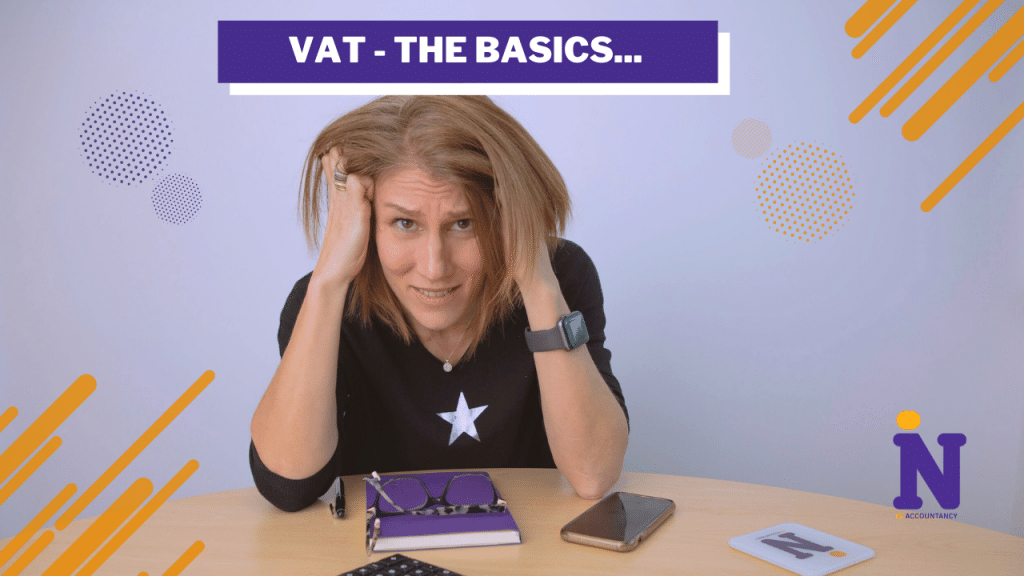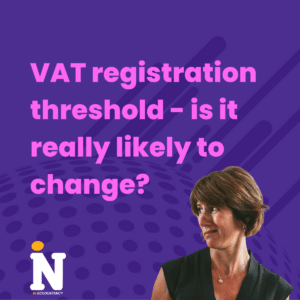VAT stands for ‘Value Added Tax’, and essentially is a sales tax on almost all goods and services considered ‘non-essential’
This article covers the VAT basics that every business owner should understand, but please remember that VAT is an incredibly complex area of tax, and that specialist advice should be sought.
Certain categories, products, services, sectors are exempt or zero rated, and there are also specific VAT rules for certain trades such as builders and charities that affect how you account for VAT, how much you must pay and how much you can reclaim.
Link to HMRC: https://www.gov.uk/guidance/rates-of-vat-on-different-goods-and-services#contents
But for now we will concentrate on understanding the basics of VAT for small business:
At what point must I register for VAT?
Every business, be they a sole trader, partnership or a limited company must register for VAT once it is known that their VATable turnover will reach £85,000 in any rolling twelve month period.
What is considered VATable turnover for registration purposes?
Certain goods and services are considered to be exempt from or outside the scope of VAT. These are excluded from your sales when monitoring the level of turnover at which you must register your business for VAT.
However reduced rate and zero rated products and services are included in your turnover, so be careful how you count!
Can every business register for VAT?
No! If you ONLY make VAT exempt supplies, then you’re not allowed to register for VAT or reclaim any VAT you pay out on your purchases.
Can I register for VAT even if my turnover won’t hit the registration threshold?
Yes, of course you can, and there are certain benefits to doing so, but remember that once you are VAT registered you are required to charge VAT on to your customers regardless of your turnover levels.
What are the advantages to registering for VAT?
Well, you can only claim back VAT you pay out on goods and services if you are VAT registered.
When starting a business you may have significant vatable start-up costs such as plant and machinery, website development and stock. If you are VAT registered, you will be able to reclaim VAT paid (usually at 20%), against any input VAT from your sales. In the early days this can often lead to a much needed cash refund as vatable costs outweigh sales.
What if I don’t register straight away? Can I still reclaim VAT paid on my start up costs?
Well, as ever, it depends…
There are different rules depending on whether you paid out VAT on goods or services. Generally, you can go back as far as four years to reclaim any VAT paid out on goods which are still held in your business. For services you have paid for however, you can only go back six months, even if for example your website is still in use in the business – the invoice for the development of this would usually be considered a service not a tangible supply.
The main thing to remember is that you must retain any VAT invoices in order to be able to reclaim the VAT you pay.
How often do I need to report, pay and reclaim any vat on sales and purchases?
Most businesses are on a quarterly VAT scheme, however there are some on an annual VAT scheme, and others who complete VAT returns monthly.
We will explore the pros and cons of different timing of reporting and paying VAT in a future article
There seem to be all sorts of different VAT schemes – what exactly are the cash accounting, accrual accounting and flat rate VAT schemes??
Another great question.
Cash and accrual accounting are fairly simple to explain:
Cash Accounting means that the VAT due (whether refund or liability) is calculated from the date at which the money relating to the goods or services sold or purchased comes into or leaves your bank account.
Accrual Accounting for VAT is calculated based upon the date of invoice, regardless of when said invoice is paid.
There are rules around each scheme, and as I am sure you can imagine, pros and cons dependent on your type of business and your client base.
The Flat rate VAT scheme (FRVS) was introduced by the government to try to simplify VAT reporting for smaller businesses by requiring less admin to calculate the VAT due.
In its simplest terms, a hairdresser for example might have a flat rate VAT of 14%. This would mean that the business owner would simply pay a flat rate of VAT of 14% on its gross sales (while charging the full 20% on), but would not be able to reclaim VAT on individual purchase invoices unless specific criteria are met.
The FRVS used to be a wonderful tool for small businesses with limited costs, but HMRC closed the loophole which effectively allowed them to make substantial money from the scheme by introducing a relatively high FRV% for what they called ‘limited cost traders’ of 16.5%
These different schemes have other criteria and rules which must be met, and will be explored in full in a future article
What do I have to do if I charge VAT?
- First and foremost you need to understand the different VAT rates (see above), so that you can both charge and reclaim correctly
- If you have an invoice with a single price on it, you need to understand whether the amount is inclusive of VAT or exclusive
- You need to show your VAT information – amount, rate, vat registration number – on your invoices
- You will also need to register correctly for MTD for VAT (MTDfV – Making Tax Digital for VAT)
What on earth is MTD for VAT?
MTD or Making Tax Digital is a government initiative to attempt to ‘close the tax gap’, by requiring all businesses to keep records digitally, and submit information regularly (meaning at least quarterly in the first instance) to HMRC via a compliant digital solution.
This started with all VAT registered businesses trading in excess of the VAT threshold in 2019, and so excluded those smaller businesses who had registered by choice.
From April 2022 MTDfV is extended to include ALL VAT registered business, regardless of turnover, and means that VAT returns can no longer be submitted manually via the ‘old’ government gateway.
So MTD is only relevant if you are VAT registered?
Well, yes. And no…
MTD will be extended to income and property tax first, followed in around 2025 to corporation tax. The roll out of MTD for ITSA (Income Tax Self Assessment) should have taken place from April 2023, but has just recently been pushed back to April 2024, meaning that sole traders, partners and landlords with sales and/or rental income greater than £10,000 per annum will also be required to keep records digitally and report quarterly.
There is a huge amount of work needed to make this happen as smoothly as possible.
First of all, HMRC are looking at Basis Period Reform to align the tax year for all sole traders with the fiscal year, and put an end to overlap relief in future. This is significant and too lengthy to go into here, so you can read about the concept in my previous article on the subject here:
https://www.in-accountancy.co.uk/2021/09/basis-period-reform-consultation/
You can also read our article on MTD for ITSA here, but please be aware this was written and published before the dates were pushed back by one year. An updated version will follow.
We will explore MTD in full, both from a VAT and a non VAT perspective in a future article
But for now, let’s get back to basics and answer some more of your questions:
How do I know which quarters my VAT returns relate to?
When you register for VAT you can request the quarters you would like to report on, however it is important to check your VAT certificate once it arrives to be sure of the correct periods.
We always recommend that clients try to make their VAT periods coterminous with your year end date as this makes for easier reporting (and this will become even more important as we move towards MTD for ITSA, but more on that separately)
How long do I have to prepare my VAT return?
You have just over a month to prepare and submit your VAT returns and to pay any associated liabilities, with the deadline falling on the 7th of each month after the month following the quarter end.
So for example, if your VAT quarter ends on 31 January, you have until 7 March to prepare, submit and pay.
Please be aware though, that this means cleared funds must be in the HMRC’s account by this date, so you will need to be careful about bank processing times and weekends or bank holidays.
Is there not an easier way to pay?
Yes, there is!
You can set up for HMRC to take your VAT payment by direct debit. Some people don’t like to do this, but actually there is a real benefit to this – Not only do you not have to think about or make time to physically pay over the monies owed, but HMRC actually give you a little more time, taking their DD around the 12th of the deadline month rather than the 7th. So it’s a win-win-win really
What if I can’t pay my liability?
If you can’t pay your liability you should contact HMRC as early as possible to make a time to pay arrangement with them. In most cases, HMRC work better with those businesses who communicate any potential issues in advance, rather than avoiding the subject and simply paying late or not at all.
Interest will be charged on any late payments at 2.6%, although if you make early payments you can only reclaim interest at 0.5% ????♀️
What happens if I don’t submit or pay on time, but don’t tell HMRC?
If you are late submitting your return or paying any liability due, then HMRC will record this as a default and put you into a ‘surcharge period’. If you default again within the surcharge period, then penalties and fines will arise.
I’m not going to go into detail on these charges as the way HMRC do this is changing – another subject for its own topic later…
What else do I need to know?
It’s important for any business owner to understand that VAT is incredibly complex, even in its simplest form and that you should never assume an answer.
If you have complex VAT queries it really is important to seek guidance from a qualified specialist.
For more simple VAT related queries, or if you need to register your business for VAT and have an accountant submit your VAT returns on your behalf, we would be very happy to help and you can contact us via the link here







